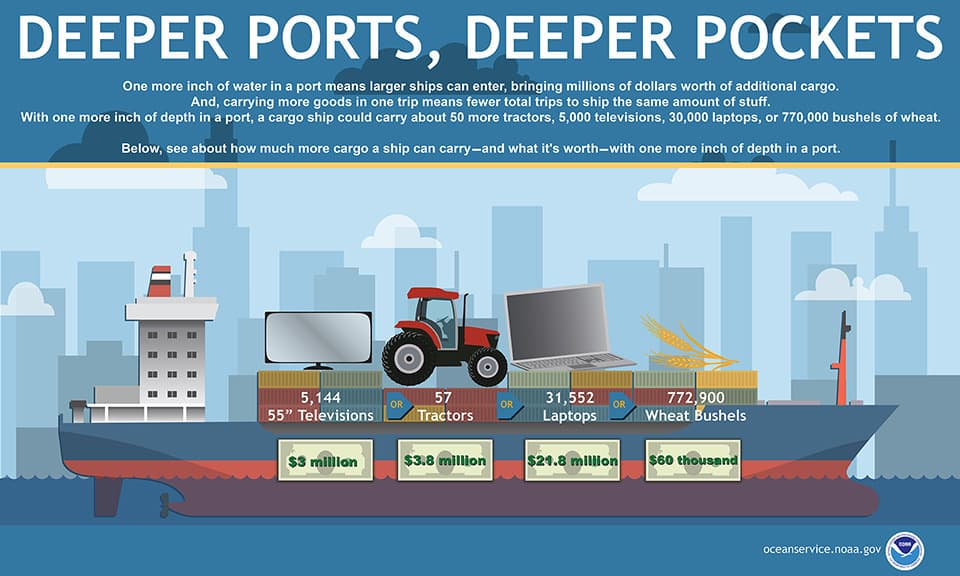An Inch of Water. What's it Worth?
An extra inch of water depth in a port = larger ships, millions of dollars worth of additional cargo.

Deeper Ports, Deeper Pockets
One more inch of water in a port means larger ships can enter, bringing millions of dollars worth of additional cargo. And, carrying more goods in one trip means fewer total trips to ship the same amount of stuff. That’s good for the safety of our waterways, it’s good for the environment, and it’s good for your wallet. Download this infographic | Infographic Text
Our nation’s ports are the lifelines of our economy. In 2017, foreign trades through U.S. ports were valued at $1.6 trillion—$527 billion exports and $1.1 trillion imports were moved by vessels. When goods travel through ports, it means they are traveling via ship.
NOS is in the business of making sure that mariners—and the goods they are transporting—make it to their destinations safely and quickly. Just as airplane pilots need to know current weather and ground conditions, ship captains need to know exactly what's going on in the water and in the air. NOS monitoring systems supply mariners with the real-time data they need, providing information such as water levels, wind and current speeds and directions, and water temperature. But what does this have to do with that inch of water?
A ship needs a certain amount of water in order to float and not touch bottom. This water depth is called the ship’s “draft.” The more cargo a ship carries, the more the ship will weigh, meaning it will sink more and require more draft. Even a slight decrease in the depth of a waterway will require a ship to reduce the amount of cargo it is carrying. On the flipside, more water means more cargo. This, in turn, translates into fewer trips needed to transport goods.
Accurate data provided by NOS are crucial to making decisions regarding ship draft and cargo loads. In the absence of this information, mariners would need to be much more conservative in their draft estimates, or risk additional maritime accidents.
Consider that carrying more cargo on a single trip means fewer trips overall to transfer the same amount of materials. That’s good for the safety of our waterways, it’s good for the environment, and, because it saves money, it’s good for your wallet.
Infographic Text
Deeper Ports, Deeper Pockets
One more inch of water in a port means larger ships can enter, bringing millions of dollars worth of additional cargo. And, carrying more goods in one trip means fewer total trips to ship the same amount of stuff. With one more inch of depth in a port, a cargo ship could carry about 50 more tractors, 5,000 televisions, 30,000 laptops, or 770,000 bushels of wheat. Below, see about how much cargo a ship can carry — and what it's worth — with one more inch of depth in a port.
57 tractors, worth more than $3.8 million
31,552 laptop computers, worth more than $21.8 million
772,900 bushels of wheat, worth more than $60,000
5,144 55-inch televisions, worth approximately $3 million
Did you know?
In 2017, the Port of Los Angeles/Long Beach increased the draft for incoming ships from 65 feet to 66 feet as a direct result of NOAA's Precision Navigation Project, with a future goal of a 69-foot draft. Each additional foot of draft allows carriage of 40,000 additional barrels of crude oil, and 69 feet would eliminate the need for lightering. The increase was made possible, in part, by the expansion of the physical observing infrastructure at the port, including forecasts for wave and swell conditions from the National Weather Service, water level data from the Center for Operational Oceanographic Products and Services, wave buoy data from the U.S. Integrated Ocean Observing System, shoreline data from the National Geodetic Survey, and high resolution bathymetry from the Office of Coast Survey. The project showcases how NOAA supports the increasingly complex decisions mariners make as they navigate ever-larger ships through U.S. ports, especially decisions related to underkeel clearance. This flagship project integrates private-sector innovation and NOAA data streams for safe navigation of deep-draft ships.
